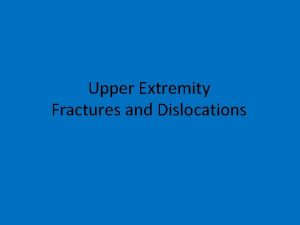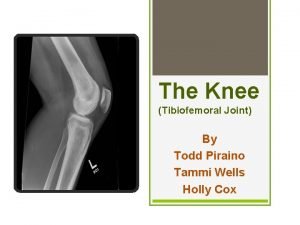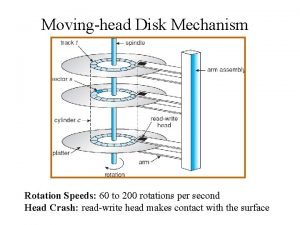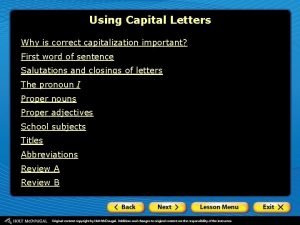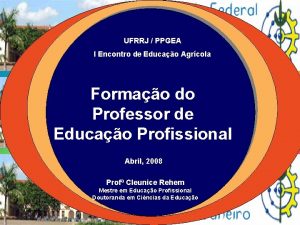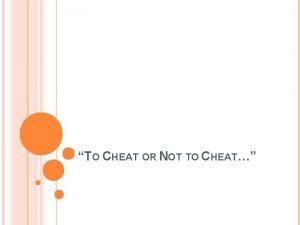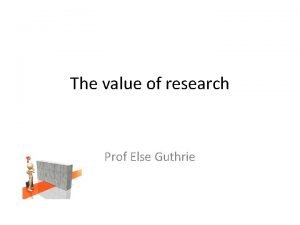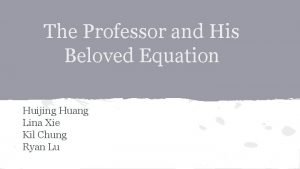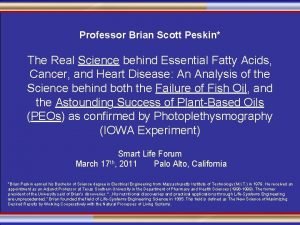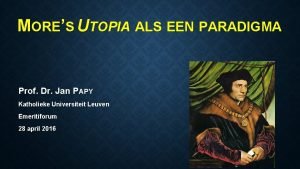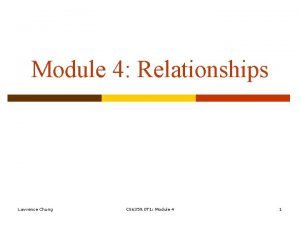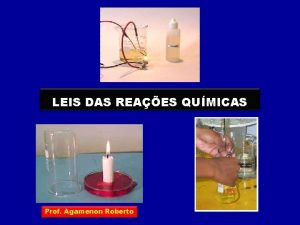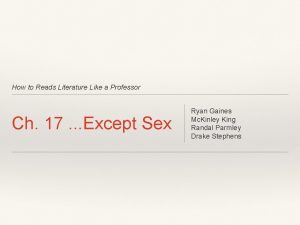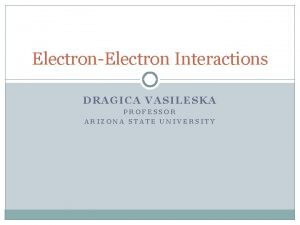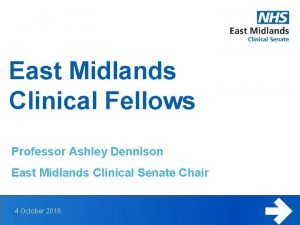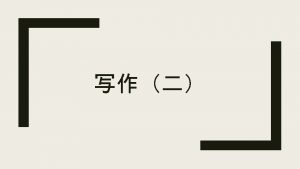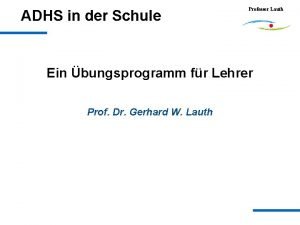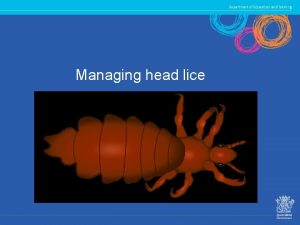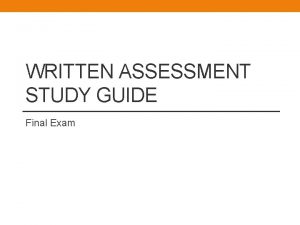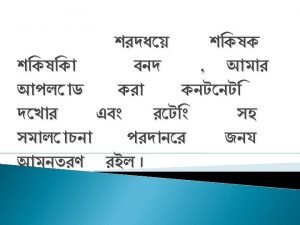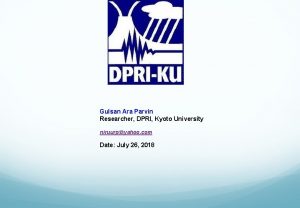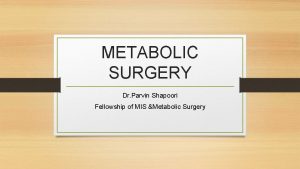Written Assessment Dr Shamima Parvin Professor Head of





















































- Slides: 53

Written Assessment

Dr. Shamima Parvin Professor & Head of Biochemistry Mugda Medical College




• “To change curriculum or instructional methods without changing assessments would achieve nothing” • “Changing the assessment system without changing the curriculum had a much more profound impact upon the nature of learning” — G. E. Miller

The curriculum instructs teachers what to teach; The exam instructs students what to learn. Donald Melnick, 1991

Or Exam


Objectives of the session • At the end the of the session fellow be able to— • identify the principle of written assessment • classify instruments/tools for written assessment • differentiate between types of instrument used • state the merits & demerits of different instrument • construct ideal written assessment instrument

Assessment ? • Why ? • What? What ? • How? How ? • When ? • ? When? By Whom • Where? Where


Why should we assess? • To pass or fail

Why should we assess? • To pass or fail

Why should we assess? • To certify

Why should we assess? • To rank

Why should we assess? • To provide feedback (Both teachers and students)


What do we assess? The curriculum outcomes & Instruction


How do you elicit a knee jerk? Flex the knee joint…………

does Workplace based assessment shows how OSCE/OSPE knows how knows Written

Principle of written assessment • Cognitive domain (Knowledge) • intellectual skills, information & fact • Psychomotor domain (Skills) • practical skills • Affective domain (Attitude) • communication skills & behavior • Educators called it KSA

Level of cognitive domain

Elements in written assessment 1. The stimulus: • Short statement or question eg …. . • Statement or question with diagram eg……? • Patient presenting with some clinical scenario followed by question …. ? • More extended patient management problem

Elements in written assessment 2. The learner’s response : • Selected response/close ended e. g. MCQs, PMPs • Constructed response/open ended —Essay Question/Traditional essay —Structured Essay Question (SEQ) —Modified Essay Question (MEQ) —Short Answer Question (SAQ) Special type of essay questions

Question setter Ex am in er Essay Question Examinee e Exa ne i m

Comparison between Traditional Essay & SEQ Traditional Essay SEQ 1. Discuss the biochemical basis 1. Answer the following and clinical features of G-6 -P-D questions: deficiency (10). a. Depict the HMP shunt pathway in RBC by using a flow chart (2. 5). b. Explain how G 6 PD deficiency will produce haemolysis in the presence of oxidant drug (2. 5). c. State two condition other than drug exposure which may trigger same state(1. 0)

Modified Essay Question (MEQ) • Problem solving type of question, consist of— • Case history • Followed by number of sequential questions • Candidates have to construct the response • Interdependency of the sequential questions • If answer of the 1 st question is incorrect, all subsequent answer will also be incorrect.

Advantages of newer format • SEQ, MEQ and PMP— ─ presents a typical problem faced in daily practice ─ encourage more complex thinking skills among students ─ help to develop problem solving & decision-making skills ─ suitable for emergency/high risk problems where a student cannot be allowed to handle real situation

The eyes cannot see what the mind does not know

What is SAQ? • SAQs are open-ended questions that require students to create an answer • Educationists have various opinion — • what actually constitute a SAQ? • SAQ typically require responses of one word/ one phrase to few sentences.

What is SAQ? • Answer should be short • A patient of pulmonary TB undergoing 4 -drug treatment regime develops peripheral neuritis. Name the drug responsible for neuritis in this patient. • Answer-Isoniazid

What is SAQ? • It may simply ask the student to write a missing word or phrase: • Anaerobic glycolysis produce— ( 0. 5) • It may call for brief listings: • List the names of ketone bodies (1. 5) • A one-sentence answer: • What is the basic principle of colorimetry? (1)

Differences between SAQ & MCQ • SAQ is similar to a well-stated MCQ without the alternatives/options • The examinee is required to generate the specific answer rather than just select from the options provided

Example • Hormone maintaining calcium homeostasis is/area. calcitonin b. calcitriol c. thyroxine d. parathyroid hormone e. Aldosterone • Name 3 hormones that maintain calcium homeostasis (1. 5)

Differences between SAQ & MCQ • These open-ended questions are more flexible than MCQ • We can test the issues that require creativity and spontaneity • By well-constructed SAQs we can even assess higher cognitive level

Differences between SAQ & MCQ • Life saving hormones are/ isa. thyroid hormones b. aldosterone c. parathyroid hormone d. insulin e. cortisol • Why PTH is considered as life saving hormone? (2)

Guideline for writing written questions

Test matrix (Blueprint) Contents Cognitive domain Knowledge 50% Application 20% Total 100% Biophysic & Biomolecule 30% 1 Comprehension 30% 1 Digestion & absorption 20% 1 1 Metabolism 30% 1 1 Food & nutrition 10% Vitamins & minerals 10% 1 1 Total=100% 5 3 1 3 2 1 2 3 10 items

Guideline for writing written questions • The statement should be worded carefully to get very specific answer • Intended answer should be write 1 st , then we have to write question • Question should be concise, clear & understandable • Statement should not be lifted as it is from text book • Unintentional correct answer cues should be avoided

Types of SAQ • Completion items (fill in the blanks) • Definition • Label/draw diagram • Unique answer type • Numerical problems • Open SAQs • Problem solving items

Example of different types of SAQs • Completion items (fill in the blanks) • Consists of incomplete sentence & examinee have to supply missing word, term, symbol etc • Type II alveolar cells of lung secrete…… • Name of the causative agent….

Example (Contd…) • Unique answer type— • Name essential fatty acid • Numerical problem SAQ— • A patient with H+ conc. 40 nmol/L. Calculate p. H of that patient • Draw /label — • Draw & label the structure of lipoprotein

Example (Contd…) • Open SAQs — • List merits & demerits of…. • Mention 4 important functions of…. • List indications of…. .

Problem solving items • A 46 years old female patient comes to you with a history of generalized weakness, palpitation, excessive sweating, and heat intolerance for the last one year. In spite of a good appetite, she has lost 10 kg of weight during this period. • What will be the possible cause of above mentioned symptom? Justify (3) • What biochemical investigations will you advise to the patient for diagnosis? (2)



Take home message

Take home message d n la u f g n i n a g e n i nts m n , r g a e n i e d l u rd le t a s b r w Re taina ce fo s n u e i s r e p x e

References • Assessment in medical education: Evolving perspectives and contemporary trends by Rita Sood & Tejinder Singh. • Essentials of medical education by Adhikari & Jayawickramarajah • Essential skills for a medical teacher by Harden and Laidlaw, • Concepts of medical education by Tahmina Begum • online resource materials


“Students work to pass, not to know. . . They do pass and they do not know” Thomas Huxley
 Parvin method elbow reduction
Parvin method elbow reduction Parvin akter banu
Parvin akter banu Hamida parveen
Hamida parveen Dr parvin akter banu
Dr parvin akter banu Promotion from associate professor to professor
Promotion from associate professor to professor Dividing head calculation formula
Dividing head calculation formula The attacking firm goes head-to-head with its competitor.
The attacking firm goes head-to-head with its competitor. The head of moving head disk
The head of moving head disk Shin body part
Shin body part What is tonic syllable
What is tonic syllable Flooded suction pump
Flooded suction pump Biceps femoris short head
Biceps femoris short head What is tone unit
What is tone unit Moving head disk mechanism
Moving head disk mechanism Head injury assessment
Head injury assessment Product principle in portfolio assessment
Product principle in portfolio assessment Define dynamic assessment
Define dynamic assessment Portfolio assessment matches assessment to teaching
Portfolio assessment matches assessment to teaching Agamenonquimica
Agamenonquimica How to write a formal email to teacher
How to write a formal email to teacher Proper adjective for java
Proper adjective for java Perfil profissional professor
Perfil profissional professor Richard quinn ucf cheating
Richard quinn ucf cheating Ruth guthrie rate my professor
Ruth guthrie rate my professor Professor's beloved equation
Professor's beloved equation Professor mso afskaffes
Professor mso afskaffes Mattie is a new sociology professor
Mattie is a new sociology professor Paraphrase in a sentence
Paraphrase in a sentence Professor edley
Professor edley Professor edley
Professor edley Brian scott peskin
Brian scott peskin Olaf wendler
Olaf wendler O bom professor
O bom professor Professor jan papy
Professor jan papy Lawrence chung rate my professor
Lawrence chung rate my professor Lei das proporções múltiplas
Lei das proporções múltiplas Ajit diwan
Ajit diwan How to read literature like a professor chapter 17
How to read literature like a professor chapter 17 Chapter 15 how to read literature like a professor
Chapter 15 how to read literature like a professor How to read literature like a professor chapter titles
How to read literature like a professor chapter titles Good morning everyone or everybody
Good morning everyone or everybody Good morning class.
Good morning class. Um submarino é equipado com um aparelho denominado sonar
Um submarino é equipado com um aparelho denominado sonar Cuhk assistant professor salary
Cuhk assistant professor salary Email format for professor
Email format for professor Dragica vasileska
Dragica vasileska East midlands clinical senate
East midlands clinical senate Dear mr professor
Dear mr professor Certificado professor nota dez
Certificado professor nota dez Is president capitalized
Is president capitalized Professor helen danesh-meyer
Professor helen danesh-meyer Signalkarten selbstinstruktion
Signalkarten selbstinstruktion Professor dr. h a m nazmul ahsan
Professor dr. h a m nazmul ahsan
